
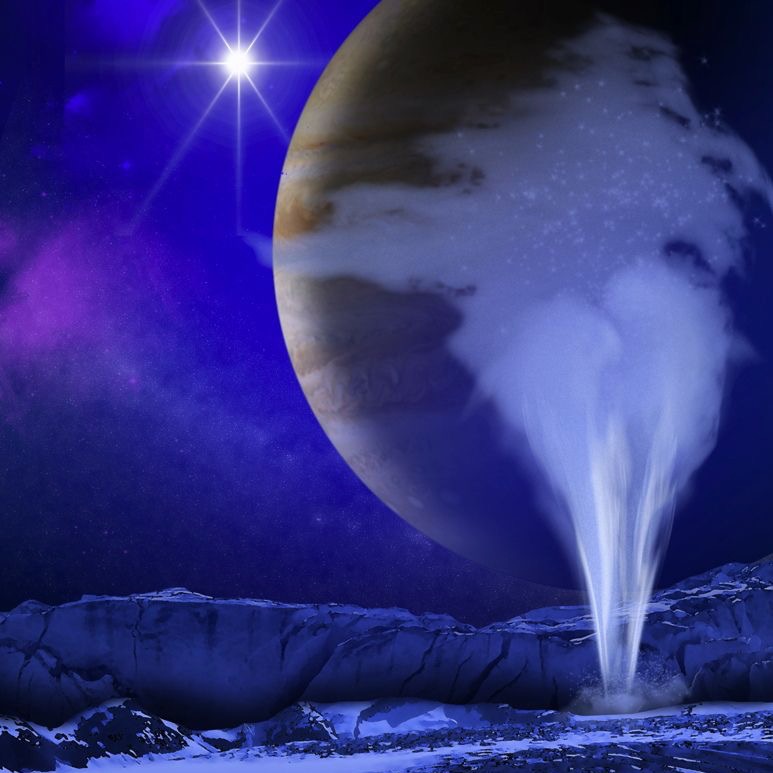
Artist’s concept of a water vapor plume on Europa, the smallest of Jupiter’s 4 large Galilean moons. Image via ASA/ ESA/ K. Retherford/ SwRI/ Science.
Jupiter’s moon Europa is known as a water world in the outer solar system. Like Saturn’s moon Enceladus, icy Europa is thought to have an ocean beneath its surface. At the surface of Enceladus, water-vapor geysers are seen erupting into space. Likewise, there’s growing evidence for plumes of water vapor that erupt from Europa’s surface. They are one reason scientists are excited about a spacecraft mission to Europa – the Europa Clipper mission – due to launch in 2024. So here’s a question. If water plumes do burst from Europa’s surface, what is their source? Do they originate in this world’s subsurface ocean (as is the case with Enceladus), or from pockets of salty water trapped in Europa’s crust?
New research announced in November 2020 by scientists at Stanford University, the University of Texas Institute for Geophysics and NASA’s Jet Propulsion Laboratory indicates that the latter may be the case: unlike Enceladus’ plumes, the plumes on Europa appear to spring from pockets of water, or salty subsurface lakes, trapped within the icy moon’s crust.
The 2021 lunar calendars are here! Order yours before they’re gone. Makes a great gift!
The peer-reviewed results were published in the journal Geophysical Research Letters on November 5, 2020.
The results come from modeling of Europa’s crust, showing that salty water – brines – could move around within the icy crust and form pockets of water that would then erupt onto the surface.
Knowing where the plumes originate from is crucial to possibly being able to detect evidence of life in Europa’s ocean, if it exists. If Europa’s plumes come from the ocean, as the plumes on Enceladus do, scientists would be able to analyze the water from the ocean itself. As Gregor Steinbrügge at Stanford University commented:
Understanding where these water plumes are coming from is very important for knowing whether future Europa explorers could have a chance to actually detect life from space without probing Europa’s ocean.
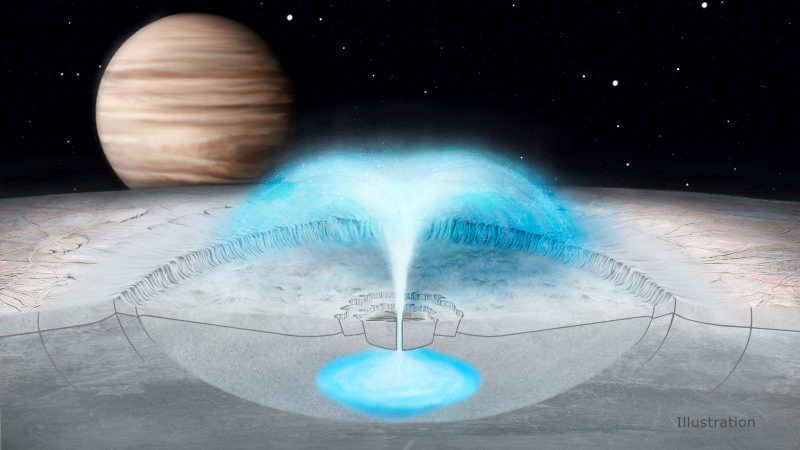
Another artist’s illustration of a cryrovolcanic eruption – or ice volcano eruption – this one showing salty water from inside the little moon’s crust, released into space at the site of an impact crater. Image via Justice Wainwright/ NASA.
Evidence continues to build that Europa’s ocean is potentially habitable, perhaps even with hydrothermal vents around which life could cluster on Europa’s ocean floor, much as deep-sea hydrothermal vents on Earth’s ocean floor support unique ecosystems. On the other hand, it’s thought that pockets of water in the moon’s crust would be less habitable; they’d lack the rich energy sources of hydrothermal vents, for example. So – if Europa’s plumes do come from pockets of brine trapped in the moon’s crust – they might not be as rich a source for analysis by those searching for life on Europa.
Why did the researchers begin to believe Europa’s plumes might come from trapped brine in the crust, rather than from this moon’s subterranean ocean?
They examined images of Europa’s surface sent back by the Galileo probe in the late 1990s and early 2000s. They used that analysis to develop a model suggesting that a combination of freezing and pressurization – from meteorite or asteroid impacts – could cause cryovolcanic eruptions, that is, eruptions of water-ice.
Europa has relatively few impact craters on its icy surface, but the researchers took a close look at Manannán Crater, an 18-mile-wide (29-km-wide) impact crater created tens of millions of years ago. The modeling indicated that the melted ice resulting from the impact, and the refreezing of the water pocket below the surface, could have resulted in an eruption. These scientists’ paper explained:
Jupiter’s satellite Europa has a subsurface ocean covered by an icy shell. We show how small pockets of brine can migrate within the ice from colder areas to warmer areas. This can happen even at very low temperatures, below the point where pure water would freeze, because the water becomes saltier and saltier as it migrates. By looking at an impact crater on Europa, which was initially warm in the center and cooled inward from its colder surroundings, we can study how the water migrated toward the center and formed a central water reservoir. As the final water pocket at the center of the crater started to freeze, the increasing pressure lead to a cryovolcanic eruption that emplaced brine onto the surface to form a prominent ‘spider’ feature before the ice collapsed into the cavity below. Using a digital terrain model of the crater and collapse feature, we estimate how much water erupted and how salty Europa’s ice shell is.
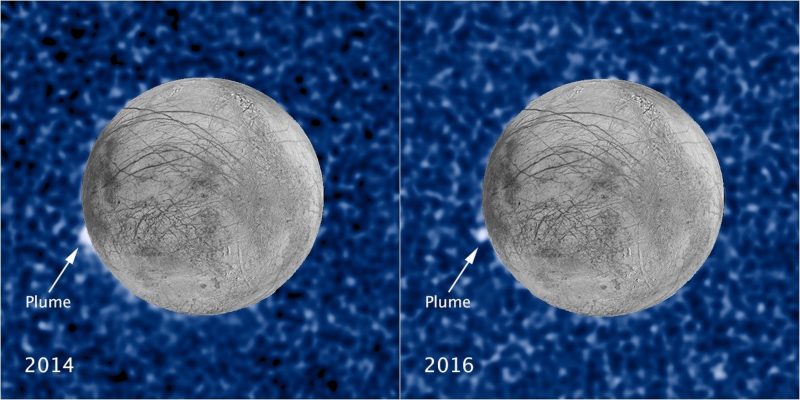
Composite photos from the Hubble Space Telescope and the Galileo spacecraft, showing a suspected plume erupting in the same place on Europa in 2014 and 2016. Image via NASA/ ESA/ W. Sparks (STScI)/ USGS Astrogeology Science Center/ JPL-Caltech.
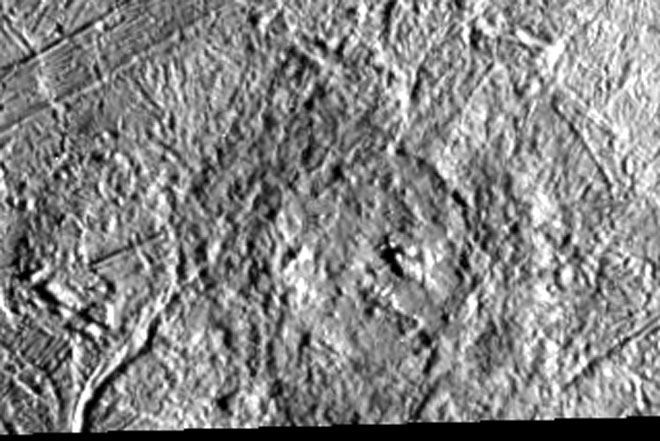
Manannán Crater on Europa, the focus of the new study and where scientists think that plumes of water have erupted. Image via E. P. Turtle/ E. Pierazzo et al./ Science.
Don Blankenship, senior research scientist at University of Texas Institute for Geophysics, added:
The comet or asteroid hitting the ice shell was basically a big experiment which we’re using to construct hypotheses to test. Our model makes specific predictions we can test using data from the radar and other instruments on Europa Clipper.
After the impact, the water partly froze into ice, but other pockets of water could have also been created in the moon’s crust. Those salty water pockets can theoretically move sideways through the crust. As they do so, they melt the adjacent ice and become even saltier in the process. Steinbrügge said:
We developed a way that a water pocket can move laterally, and that’s very important. It can move along thermal gradients, from cold to warm, and not only in the down direction as pulled by gravity.
In the case of Europa’s Manannán Crater, the scientists think that one of these briny water pockets reached the middle of the crater. After it became stuck there, it started to freeze, which created pressure resulting in a plume-like eruption. The eruption even left a spider-shaped marking on Europa’s surface, which was seen by Galileo.
So while plumes from brine pockets trapped in Europa’s crust wouldn’t provide much information about this little moon’s subsurface ocean, they would show how the outer ice crust is geologically active. Joana Voigt, a graduate research assistant at the University of Arizona, added:
Even though plumes generated by brine pocket migration would not provide direct insight into Europa’s ocean, our findings suggest that Europa’s ice shell itself is very dynamic.

Gregor Steinbrügge at Stanford University, lead author of the new study. Image via Stanford University.
As co-author Dustin Schroeder at Stanford also said:
This makes the shallow subsurface – the ice shell itself – a much more exciting place to think about. It opens up a whole new way of thinking about what’s happening with water near the surface.
The hypothesized plume at Manannán Crater would have been relatively small, smaller than other larger plumes for which there is growing evidence from Galileo data and the Hubble Space Telescope. This means, the researchers say, that larger plumes are probably not caused by impact events. As to how they occur, scientists don’t know yet, but if there is an ocean-related mechanism similar to that on Enceladus, that would be exciting. As Robert Pappalardo at NASA’s Jet Propulsion Laboratory noted:
The work is exciting, because it supports the growing body of research showing there could be multiple kinds of plumes on Europa. Understanding plumes and their possible sources strongly contributes to Europa Clipper’s goal to investigate Europa’s habitability.
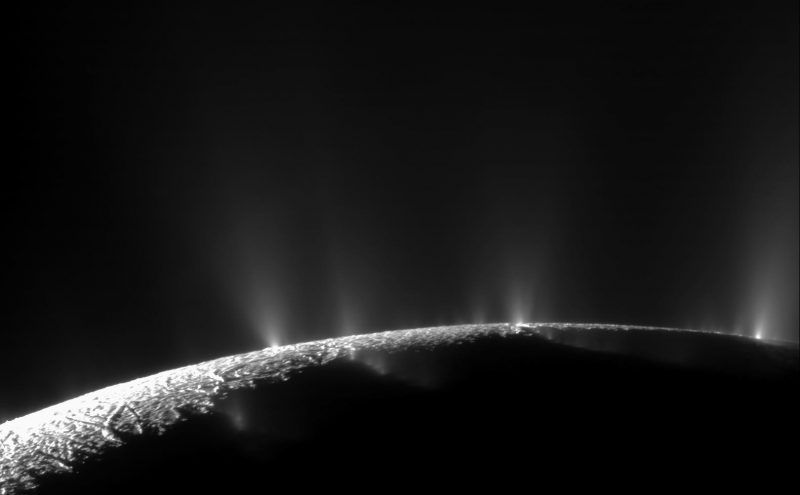
While Europa’s water plumes haven’t quite been fully confirmed yet, the ones on Saturn’s moon Enceladus certainly have. They originate from the moon’s subsurface salty ocean. Image via NASA Science.
The results also suggest that similar plumes could be created on other icy bodies as well. According to Voigt:
Brine pocket migration is not uniquely applicable to Europan craters. Instead the mechanism might provide explanations on other icy bodies where thermal gradients exist.
Determining with certainty the source or sources of Europa’s plumes will probably require in situ observations, and thankfully, NASA’s upcoming Europa Clipper mission, scheduled to launch in 2024, should be able to do that. Even now, there is still some debate as to whether the plumes even exist at all, but the accumulating evidence from Hubble has almost confirmed them now. Even if some of these plumes don’t originate from the ocean itself, it’s still possible that other ones do. Europa Clipper will study Europa in unprecedented detail, and hopefully answer this question as well as many others that scientists have about this fascinating little world.
Bottom line: Scientists now think that at least some of Europa’s watery plumes originate from pockets of salty water in the crust.
Source: Brine Migration and Impact-Induced Cryovolcanism on Europa
from EarthSky https://ift.tt/35KJ1uP


Artist’s concept of a water vapor plume on Europa, the smallest of Jupiter’s 4 large Galilean moons. Image via ASA/ ESA/ K. Retherford/ SwRI/ Science.
Jupiter’s moon Europa is known as a water world in the outer solar system. Like Saturn’s moon Enceladus, icy Europa is thought to have an ocean beneath its surface. At the surface of Enceladus, water-vapor geysers are seen erupting into space. Likewise, there’s growing evidence for plumes of water vapor that erupt from Europa’s surface. They are one reason scientists are excited about a spacecraft mission to Europa – the Europa Clipper mission – due to launch in 2024. So here’s a question. If water plumes do burst from Europa’s surface, what is their source? Do they originate in this world’s subsurface ocean (as is the case with Enceladus), or from pockets of salty water trapped in Europa’s crust?
New research announced in November 2020 by scientists at Stanford University, the University of Texas Institute for Geophysics and NASA’s Jet Propulsion Laboratory indicates that the latter may be the case: unlike Enceladus’ plumes, the plumes on Europa appear to spring from pockets of water, or salty subsurface lakes, trapped within the icy moon’s crust.
The 2021 lunar calendars are here! Order yours before they’re gone. Makes a great gift!
The peer-reviewed results were published in the journal Geophysical Research Letters on November 5, 2020.
The results come from modeling of Europa’s crust, showing that salty water – brines – could move around within the icy crust and form pockets of water that would then erupt onto the surface.
Knowing where the plumes originate from is crucial to possibly being able to detect evidence of life in Europa’s ocean, if it exists. If Europa’s plumes come from the ocean, as the plumes on Enceladus do, scientists would be able to analyze the water from the ocean itself. As Gregor Steinbrügge at Stanford University commented:
Understanding where these water plumes are coming from is very important for knowing whether future Europa explorers could have a chance to actually detect life from space without probing Europa’s ocean.

Another artist’s illustration of a cryrovolcanic eruption – or ice volcano eruption – this one showing salty water from inside the little moon’s crust, released into space at the site of an impact crater. Image via Justice Wainwright/ NASA.
Evidence continues to build that Europa’s ocean is potentially habitable, perhaps even with hydrothermal vents around which life could cluster on Europa’s ocean floor, much as deep-sea hydrothermal vents on Earth’s ocean floor support unique ecosystems. On the other hand, it’s thought that pockets of water in the moon’s crust would be less habitable; they’d lack the rich energy sources of hydrothermal vents, for example. So – if Europa’s plumes do come from pockets of brine trapped in the moon’s crust – they might not be as rich a source for analysis by those searching for life on Europa.
Why did the researchers begin to believe Europa’s plumes might come from trapped brine in the crust, rather than from this moon’s subterranean ocean?
They examined images of Europa’s surface sent back by the Galileo probe in the late 1990s and early 2000s. They used that analysis to develop a model suggesting that a combination of freezing and pressurization – from meteorite or asteroid impacts – could cause cryovolcanic eruptions, that is, eruptions of water-ice.
Europa has relatively few impact craters on its icy surface, but the researchers took a close look at Manannán Crater, an 18-mile-wide (29-km-wide) impact crater created tens of millions of years ago. The modeling indicated that the melted ice resulting from the impact, and the refreezing of the water pocket below the surface, could have resulted in an eruption. These scientists’ paper explained:
Jupiter’s satellite Europa has a subsurface ocean covered by an icy shell. We show how small pockets of brine can migrate within the ice from colder areas to warmer areas. This can happen even at very low temperatures, below the point where pure water would freeze, because the water becomes saltier and saltier as it migrates. By looking at an impact crater on Europa, which was initially warm in the center and cooled inward from its colder surroundings, we can study how the water migrated toward the center and formed a central water reservoir. As the final water pocket at the center of the crater started to freeze, the increasing pressure lead to a cryovolcanic eruption that emplaced brine onto the surface to form a prominent ‘spider’ feature before the ice collapsed into the cavity below. Using a digital terrain model of the crater and collapse feature, we estimate how much water erupted and how salty Europa’s ice shell is.

Composite photos from the Hubble Space Telescope and the Galileo spacecraft, showing a suspected plume erupting in the same place on Europa in 2014 and 2016. Image via NASA/ ESA/ W. Sparks (STScI)/ USGS Astrogeology Science Center/ JPL-Caltech.

Manannán Crater on Europa, the focus of the new study and where scientists think that plumes of water have erupted. Image via E. P. Turtle/ E. Pierazzo et al./ Science.
Don Blankenship, senior research scientist at University of Texas Institute for Geophysics, added:
The comet or asteroid hitting the ice shell was basically a big experiment which we’re using to construct hypotheses to test. Our model makes specific predictions we can test using data from the radar and other instruments on Europa Clipper.
After the impact, the water partly froze into ice, but other pockets of water could have also been created in the moon’s crust. Those salty water pockets can theoretically move sideways through the crust. As they do so, they melt the adjacent ice and become even saltier in the process. Steinbrügge said:
We developed a way that a water pocket can move laterally, and that’s very important. It can move along thermal gradients, from cold to warm, and not only in the down direction as pulled by gravity.
In the case of Europa’s Manannán Crater, the scientists think that one of these briny water pockets reached the middle of the crater. After it became stuck there, it started to freeze, which created pressure resulting in a plume-like eruption. The eruption even left a spider-shaped marking on Europa’s surface, which was seen by Galileo.
So while plumes from brine pockets trapped in Europa’s crust wouldn’t provide much information about this little moon’s subsurface ocean, they would show how the outer ice crust is geologically active. Joana Voigt, a graduate research assistant at the University of Arizona, added:
Even though plumes generated by brine pocket migration would not provide direct insight into Europa’s ocean, our findings suggest that Europa’s ice shell itself is very dynamic.

Gregor Steinbrügge at Stanford University, lead author of the new study. Image via Stanford University.
As co-author Dustin Schroeder at Stanford also said:
This makes the shallow subsurface – the ice shell itself – a much more exciting place to think about. It opens up a whole new way of thinking about what’s happening with water near the surface.
The hypothesized plume at Manannán Crater would have been relatively small, smaller than other larger plumes for which there is growing evidence from Galileo data and the Hubble Space Telescope. This means, the researchers say, that larger plumes are probably not caused by impact events. As to how they occur, scientists don’t know yet, but if there is an ocean-related mechanism similar to that on Enceladus, that would be exciting. As Robert Pappalardo at NASA’s Jet Propulsion Laboratory noted:
The work is exciting, because it supports the growing body of research showing there could be multiple kinds of plumes on Europa. Understanding plumes and their possible sources strongly contributes to Europa Clipper’s goal to investigate Europa’s habitability.

While Europa’s water plumes haven’t quite been fully confirmed yet, the ones on Saturn’s moon Enceladus certainly have. They originate from the moon’s subsurface salty ocean. Image via NASA Science.
The results also suggest that similar plumes could be created on other icy bodies as well. According to Voigt:
Brine pocket migration is not uniquely applicable to Europan craters. Instead the mechanism might provide explanations on other icy bodies where thermal gradients exist.
Determining with certainty the source or sources of Europa’s plumes will probably require in situ observations, and thankfully, NASA’s upcoming Europa Clipper mission, scheduled to launch in 2024, should be able to do that. Even now, there is still some debate as to whether the plumes even exist at all, but the accumulating evidence from Hubble has almost confirmed them now. Even if some of these plumes don’t originate from the ocean itself, it’s still possible that other ones do. Europa Clipper will study Europa in unprecedented detail, and hopefully answer this question as well as many others that scientists have about this fascinating little world.
Bottom line: Scientists now think that at least some of Europa’s watery plumes originate from pockets of salty water in the crust.
Source: Brine Migration and Impact-Induced Cryovolcanism on Europa
from EarthSky https://ift.tt/35KJ1uP

Aucun commentaire:
Enregistrer un commentaire